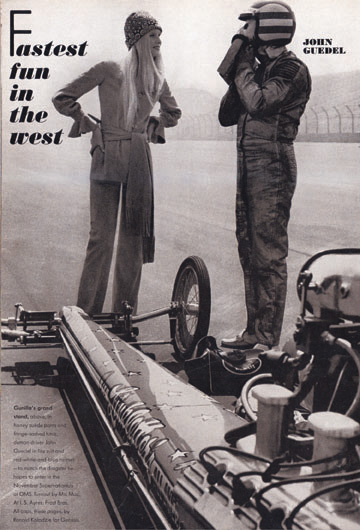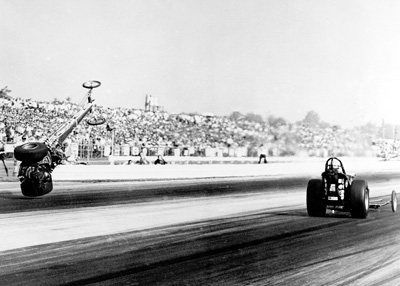

Show and tell
 |
It’s been a busy week here at NHRA Publications Central, what with back-to-back national events, the production of the souvenir program for the National Hot Rod Reunion, and intense work on a super-secret Publications project that I hope to be able to share with you all soon, so, as we toil to get Issue 18 of National DRAGSTER 2008 out the door and on its way to the printing presses in beautiful Beaver Dam, Wis., I figured I’d make this one easy on the eyes with a little show and tell.
We all know that NHRA has been in some pretty highfalutin places lately, such as Sports Illustrated, Men’s Fitness, Good Morning America, The Tonight Show with Jay Leno, etc., but did you know that an NHRA dragster once made the pages of super-fab Vogue magazine? 'Tis true.
Now, I’m not a Vogue reader — my tastes run more to Maxim and Stuff — but I understand that it’s one of the leading fashion and lifestyle magazines out there. It was founded in 1892, which means they’ve put out around 1,400 monthly issues (Ha! DRAGSTER is on number 2,271!), but the only one I care about is the August 1970 issue.
It was the Look Young issue, and the cover featured scintillating blurbs such as “Terrific New Clothes Starting at $15” (this was 1970, remember), “The Beautiful Throat: Unique Exercise Routine” and “Good Skin: How To Have It … How To Fake It,” along with a fair-haired maiden who was the subject of the issue’s fashion shoot, which was done at then-new Ontario Motor Speedway, home to be of the inaugural NHRA Supernationals later that year.
The front-engine Top Fueler – a California Chassis Engineering-built machine with a Tom Hanna body, paint by Bill Carter, and 392 Chrysler power courtesy of Ed Pink – was owned by former ND Editor (and regular column tidbit contributor) Bill Holland and partner and driver John Guedel. The car, Art Linkletter's All-American, was a prop for the shoot, which also incorporated Guedel (“a proponent of the one-piece ‘silverized’ driving suits,” noted Holland) posed in his driving gear. Guedel’s father was the producer of Linkletter’s popular television show and others, including Groucho Marx's, hence the "sponsorship."
A male model also was used in the shoot: a then unknown Michael Douglas, who two years later would burst onto the small screen as Inspector Steve Keller opposite Karl Malden on the TV show The Streets of San Francisco.
“Back then, we were actively trying to promote the sport of drag racing to the mainstream media and had reasonable success,” remembered Holland. “They were looking for a nice car that was L.A.-based. As John and I were always trying to get extra exposure for our car and drag racing, we volunteered for the gig. Me working for NHRA may have given us an inside track. We also did a national TV spot for Certs breath mints with the car, which was shot at OCIR.”

 |
 |
Speaking of promotions, former Top Fuel racer Don Roberts, another regular reader of this thrice-weekly compendium of nonsense, passed along this crazy photo of the two-car King & Marshall team doing a bit of a sticky shtick for Loctite and its then-new Super Bonder glue in April 1972.
“We glued an aluminum bar and a steel bar together with Super Bonder, hooked them to the cars, and tried to pull the bars apart not once but twice,” he recalled. “The bars stayed together. We did this promotion in the infield at Seekonk Speedway in Seekonk, Mass. Don Marshall is seen to the right giving the signal to a crew guy standing in front of me at the wheel of the dragster and to another crew guy standing in front of [Jimmy] King, who was at the wheel of the Duster Funny Car.”
King, of course, was more famous for another photo, the one at right. At the 1970 Nationals in Indy, he backflipped his slingshot just off the line, and the next week, the surprisingly lightly damaged car was back in action with a wheel attached to the top of the roll cage. I asked Roberts what he knew about that whole deal.
“The motor bogged on the leave, the clutch hooked, and a pair of Marvin Rifchin's newest sticky-compound tires put the car up in the air, and from there it stood straight up on the push bar,” he recalled. “The car and King fell over backwards to the right and landed upside down. In 1970, the term ‘wheelie bar’ didn't exist for Top Fuel dragsters, but I am sure if the car had them, it would have helped in this situation.
“King wasn't hurt, and the car had little damage and was back racing the following weekend. The guys in the shop screwed the caster on the cage when King wasn't looking as a goof. All the caster ever got was strange looks and caught on my firesuit pants getting in the car.”
There’s a nice photo bio of Roberts on Bill Pratt’s DragList.com site.

 |
After my recent column about the Vallco Drag Racing Game – creator Greg Zyla has been delightedly overwhelmed by the renewed interest in his 30-year-old baby – I was reminded by reader David Moore of another of the options that young drag racing fans had to get behind the wheel: Hasbro’s handheld Red Line Pro Drag Racing game. He had recently come across one on eBay.
With its butterfly-wheel design, the game allowed fans to compete in Top Fuel, Funny Car, Pro Stock, or Stock with a full or Pro Tree. You’d mash the gas thumb button on the right and shift with the thumb button on the left (three speeds each for Top Fuel and Funny Car, five for Pro Stock, and four for Stock) while an LCD representation of the track, your tachometer, and the scoreboard let you know where you stood. You had to beat preset opponent performances for each class on each type of Tree (for example, you needed to run consectutive rounds of 4.97, 4.82, and 4.67 to reach the Top Fuel final, where you needed to run 4.52 to win -- or 4.32, for some reason, if you raced on a full Tree).
Being the computer nerd/research junkie that I am, I actually found a PDF set of instructions for the game online (“Racing tips: Peel-out sound and ‘smoke’ on your screen mean your RPMs were too high …”), where you can read more about it, including the required e.t.s.
 |
Update! No sooner had I published this entry than I got an e-mail from reader Frankie LoCascio, who pointed out that the Hasbro game, introduced in 1999, is actually an updated version of the game that Kenner (famous for those cool zip-cord SSP cars!) made in the 1980s. Kenner was bought by in 1985 General Mills, which sold it to Tonka in 1987, which sold it to Hasbro in mid-1991. Hence, the different brand names on essentially the same product.
So, thanks to the instant and always correctable and appendable nature of the Web, here’s an update! Here’s a pic of the older version, which is a lot more square and dated looking and does not have the cool LCD screen of its successor. This version had four classes, with Modified substituted for Pro Stock, and the Tree is at the top instead of at the side.
In what was a pretty cool idea, Hasbro teamed with Travelodge hotels in June 1998 to make Pro Drag Racing and its other handheld game, Trivial Pursuit, available to sample at the check-in desks of 300 of Travelodge's most popular locations with the plan to expand to the entire chain in the fall when four other new titles, including Monopoly and Totally Twister, hit the shelves. The products also would also get a trial on cruise lines such as Carnival and Royal Caribbean as well as in Discovery Zone play centers.



















































